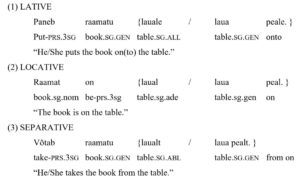Jane Klavan, University of Tartu
The paper focuses on the linguistic knowledge of alternating morphosyntactic constructions as attested in native speakers’ preferential choices and ratings. It contributes to the growing body of research that suggests the importance of alternation studies for the empirical foundation of usage-based construction grammar (e.g. Bresnan 2007; Cappelle 2006; Divjak et al. 2016; Gries & Stefanowitsch 2004; Klavan & Divjak 2016; Perek 2012; Szmrecsanyi et al. 2016; Van de Velde 2014). The alternating constructions of interest are three morphosyntactic alternations in Estonian – between the exterior locative cases allative, adessive and ablative and the corresponding postpositions peale ‘onto’, peal ‘on’ and pealt ‘off’ (examples 1 – 3).

The overall frequencies of the alternating constructions are very different. Case constructions are almost 100 times more frequent than the corresponding postpositional constructions. It is predicted that the strength of different factors on speakers’ choices will vary by the types and frequencies of constructions. It is predicted that the direction of the effects is the same, but the three alternations exhibit different constraints on their use. The corpus data used in the study constitutes a sample of 3,000 sentences (500 per construction) from the Estonian National Corpus (ENC 2017; 1,3 billion words). Experimental data comprises a forced choice (75 participants) and an acceptability rating task (105 participants).
Mixed-effects logistic regression analysis shows that although the direction of the effects for the predictors is the same across three alternations, the ranking and selection of predictors is different. For lative and locative, length, mobility and syntactic function of Landmark phrase are the strongest predictors. For separative, mobility and complexity are the strongest predictors followed by position and length. It seems that the more frequent the construction, the less constraints we have. This result is, by and large, confirmed by native speaker behaviour as attested in two experiments.
The paper shows that the grammatical knowledge of Estonian exterior locative constructions is probabilistic and regulated by the predictors in a relatively uniform way: the postpositional constructions are preferred with short, mobile entities functioning as adverbials; the case constructions are preferred with longer, static entities functioning as modifiers. What differs is the ranking and selection of predictors across the different alternations. The results of the paper have wider theoretical implications for the empirical foundations of alternation studies. Native speaker behaviour as attested in corpora and linguistic experiments indicates that there are differences in the linguistic knowledge of alternating morphosyntactic constructions.
References
Bresnan, Joan. 2007. Is syntactic knowledge probabilistic? Experiments with the English dative alternation. In Sam Featherston & Wolfgang Sternefeld (eds.), Roots: Linguistics in search of its evidential base, 75–96. Berlin: Mouton de Gruyter.
Cappelle, Bert. 2006. Particle placement and the case for “allostructions”. Constructions online SV1-7. 1–28.
Divjak, Dagmar, Antti Arppe & Ewa Dąbrowska. 2016. Machine meets man: Evaluating the psychological reality of corpus-based probabilistic models. Cognitive Linguistics 27(1). 1–33.
Gries, Stefan Th. & Anatol Stefanowitsch. 2004. Extending collostructional analysis: A corpus-based perspective on ‘alternations’. International Journal of Corpus Linguistics 9(1). 97-129.
Klavan, Jane & Dagmar Divjak. 2016. The cognitive plausibility of statistical classification models: Comparing textual and behavioral evidence. Folia Linguistica 50(2). 355–384.
Perek, Florent. 2012. Alternation-based generalizations are stored in the mental grammar: Evidence from a sorting task experiment. Cognitive Linguistics 23(3). 601-635. DOI: https://doi.org/10.1515/cog-2012-0018
Szmrecsanyi, Benedikt, Jason Grafmiller, Benedikt Heller & Melanie Röthlisberger. 2016. Around the world in three alternations: Modeling syntactic variation in varieties of English. English World-Wide 37(2). 109–137. DOI:https://doi.org/10.1075/eww.37.2.01szm
Van de Velde, Freek. 2014. Degeneracy: The maintenance of constructional networks. In Ronny Boogaart, Timothy Colleman & Gijsbert Rutten (eds.), Extending the scope of Construction Grammar, 141–179. Berlin: De Gruyter Mouton.
